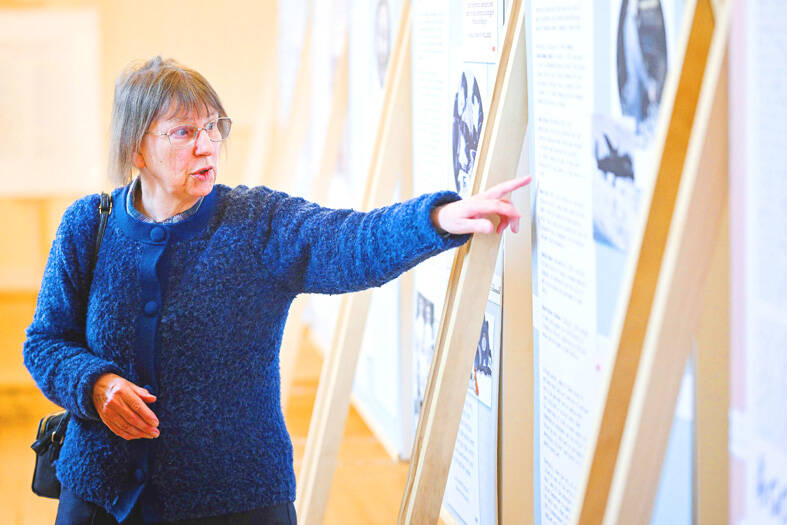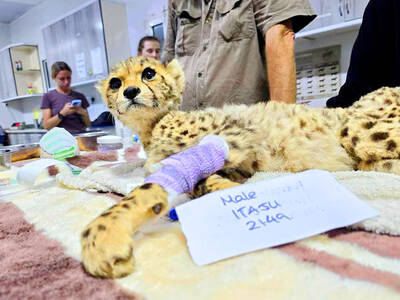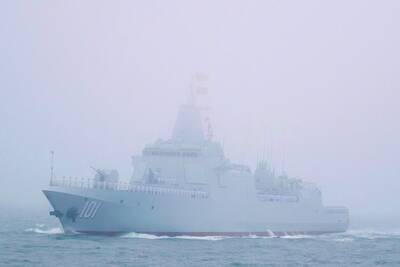During World War II, dozens of female students from the University of Cambridge worked around the clock in complete secrecy to crack Nazi codes, but only now are the unsung heroes getting recognition.
At least 77 women from the female-only Newnham College were drafted to Bletchley Park, the code-breaking center north of London, during the conflict. It was there that mathematician Alan Turing decoded messages encrypted by the Nazis’ Enigma machine, in particular those sent by German U-boats in the North Atlantic.
Historians widely acknowledge that Bletchley Park played a key role in bringing down Adolf Hitler, but the story of the Cambridge women has only recently been revealed thanks to research started by Sally Waugh five years ago.

Photo: AFP
The 69-year-old former Newnham student and teacher said she wanted to highlight the role of women in this period, often ignored in history books.
“Nobody was ever able to say thank you,” Waugh said. “I had no idea that people from Newnham went to work at Bletchley Park.”
Then one day, she came across an article mentioning the name of an old friend, Jane Monroe, who died in 2005.
When Monroe, a mathematician from Newnham, was asked what she had done during the war, she replied unfazed: “Oh, I made tea,” Waugh said.
“She was in reality a code breaker. She was a friend, but she didn’t tell me,” she said.
Monroe was unable to talk about her role as she had signed the Official Secrets Act, which restricts the publication of government information deemed sensitive.
The article mentioned three other women, whom Waugh tracked down in the university’s archives.
“I thought, if there are four of them, I wonder if there are any more?” she said.
In fact, Waugh found about 20 names and then cross-referenced her information with Bletchley Park. Together they were able to identify almost 80 women.
The only one whose name has so far gone down in history is mathematician Joan Clarke, who was recruited in 1940 and worked with the celebrated Enigma decoder and computer scientist Turing, to whom she was briefly engaged.
She became deputy head of her unit and after the war continued to work in intelligence.
Keira Knightley won an Oscar nomination for her portrayal of Clarke in the 2014 film The Imitation Game.
Also on the list is Violet Cane, another mathematician with a gift for statistics. She worked at Bletchley Park’s naval section between 1942 and 1945.
German speaker Elizabeth Langstaff was given the tasks of reconstructing German messages from raw decryptions, interpreting abbreviations and analyzing the results over months.
At the end of last year, a Newnham archivist uncovered a letter dated Jan. 28, 1939, in which the head of the university confirmed to Bletchley Park that “in the event of emergency we should be able to find for you about six students proficient in Modern Languages, in order for work to be carried out at the Foreign Office.”
Newnham, which was founded in 1871, eventually sent Bletchley Park mathematicians, linguists, historians and even archeologists to analyze aerial photographs.
“Newnham women were represented in most key areas of Bletchley Park’s work,” said Jonathan Byrne, oral history officer at the Bletchley Park Trust.
That included decrypting German signals encrypted by Enigma, producing intelligence reports, understanding the activities of the Nazis by analyzing signal networks and studying diplomatic signals.
About 50 of the women were believed to have been on duty on June 6, 1944 — D-Day — when Allied forces landed on the beaches of Nazi-occupied northern France.
“Although the work they were involved in contributed to Allied planning for the liberation, most would have not known when the invasion was happening,” said Byrne, although some might have suspected.
“German signal traffic in France increased in response to the invasion, making early June 1944 a busy time at Bletchley Park,” he said.

END OF AN ERA: The vote brings the curtain down on 20 years of socialist rule, which began in 2005 when Evo Morales, an indigenous coca farmer, was elected president A center-right senator and a right-wing former president are to advance to a run-off for Bolivia’s presidency after the first round of elections on Sunday, marking the end of two decades of leftist rule, preliminary official results showed. Bolivian Senator Rodrigo Paz was the surprise front-runner, with 32.15 percent of the vote cast in an election dominated by a deep economic crisis, results published by the electoral commission showed. He was followed by former Bolivian president Jorge “Tuto” Quiroga in second with 26.87 percent, according to results based on 92 percent of votes cast. Millionaire businessman Samuel Doria Medina, who had been tipped

ELECTION DISTRACTION? When attention shifted away from the fight against the militants to politics, losses and setbacks in the battlefield increased, an analyst said Recent clashes in Somalia’s semi-autonomous Jubaland region are alarming experts, exposing cracks in the country’s federal system and creating an opening for militant group al-Shabaab to gain ground. Following years of conflict, Somalia is a loose federation of five semi-autonomous member states — Puntland, Jubaland, Galmudug, Hirshabelle and South West — that maintain often fractious relations with the central government in the capital, Mogadishu. However, ahead of elections next year, Somalia has sought to assert control over its member states, which security analysts said has created gaps for al-Shabaab infiltration. Last week, two Somalian soldiers were killed in clashes between pro-government forces and

Ten cheetah cubs held in captivity since birth and destined for international wildlife trade markets have been rescued in Somaliland, a breakaway region of Somalia. They were all in stable condition despite all of them having been undernourished and limping due to being tied in captivity for months, said Laurie Marker, founder of the Cheetah Conservation Fund, which is caring for the cubs. One eight-month-old cub was unable to walk after been tied up for six months, while a five-month-old was “very malnourished [a bag of bones], with sores all over her body and full of botfly maggots which are under the

BRUSHED OFF: An ambassador to Australia previously said that Beijing does not see a reason to apologize for its naval exercises and military maneuvers in international areas China set off alarm bells in New Zealand when it dispatched powerful warships on unprecedented missions in the South Pacific without explanation, military documents showed. Beijing has spent years expanding its reach in the southern Pacific Ocean, courting island nations with new hospitals, freshly paved roads and generous offers of climate aid. However, these diplomatic efforts have increasingly been accompanied by more overt displays of military power. Three Chinese warships sailed the Tasman Sea between Australia and New Zealand in February, the first time such a task group had been sighted in those waters. “We have never seen vessels with this capability